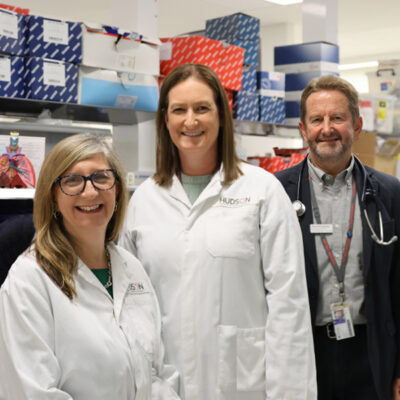New treatment for lung disease COPD “hiding in plain sight”
By Rob Clancy, staff writer. Reviewed by Professor Philip Bardin

Researchers have found a promising treatment breakthrough for Chronic Obstructive Pulmonary Disease (COPD) that avoids many drawbacks of current drugs, and it has come from an unexpected place.
COPD is an umbrella term for a number of lung conditions, including emphysema and chronic bronchitis. The disease makes breathing difficult, is often complicated by sudden severe attacks and usually worsens over time.
In Australia it affects around 2 million people and is a significant cause of morbidity and mortality, especially in people over the age of 40 years.
Now studies at Hudson Institute of Medical Research, in conjunction with Monash Health and the Monash Biomedicine Discovery Institute, have found that a drug commonly used to treat lung fibrosis could also be ideal for overcoming key problems associated with current treatments for COPD.
COPD treatment often requires steroids
Dr Belinda Thomas from the Respiratory and Lung Research group said the current standard of care for COPD usually includes steroids, drugs which are good at reducing inflammation. However, sudden attacks of COPD (called exacerbations) are usually caused by viruses and steroids encourage their replication, making things worse.
Steroids can fix one problem (inflammation) – but cause another.
The team at Hudson Institute of Medical Research used a laboratory pre-clinical model that mimics COPD to test the drug Pirfenidone and the results were promising.
“Compared to steroids, Pirfenidone reduced disease severity, lowering both virus replication and airway inflammation, without reducing the immune response, which is what the steroids do.” Dr Thomas said.
“Steroids are really packed with adverse effects but there’s been nothing to replace them until now and we believe Pirfenidone is an exciting option.”
Steroids’ benefits come at a price
Professor of Respiratory Medicine and Emeritus Director, Monash Lung Sleep Allergy & Immunology, Philip Bardin, who oversaw the research, said the side-effects of steroids can be horrendous – diabetes, hypertension, heart disease, osteoporosis, obesity, skin changes and effects on sleep.
“They’re wonderful for inflammation, but it comes at a price.” he said.
“Pirfenidone had the opposite effect to steroids, in a way, because it dampened down infection and it helped with inflammation, whereas with steroids the infection was made worse, though it helped somewhat with inflammation.”
“The great benefit if this treatment is translated into the clinic is that people could come off steroids,” he said. “Detrimental effects of steroids build up over time so that by the age of 60 many people start having severe side effects such as cardiac disease, hypertension, diabetes, skin problems and osteoporosis.”
Pirfenidone is registered for use in idiopathic pulmonary fibrosis in Australia and world-wide.
Prof Bardin, Dr Thomas and the team have now published their findings in the American Journal of Respiratory Cell and Molecular Biology and their findings have also been highlighted in an editorial comment in Lancet Respiratory Medicine.
“We have a robust pre-clinical model showing that it works and there is likely to be a lot of interest in repurposing Pirfenidone in COPD.” Dr Thomas said.
“Steroids are commonly used and people just accept the fact that they have all these limitations, because people don’t think there is anything else. Pirfenidone was really hiding in plain sight – people were excited that it was stopping or slowing lung fibrosis, but until now no-one had anticipated that it could have this important extra benefit.”
“It can prevent and treat flares of COPD, the event that can lead to premature death in COPD – when people get severe infections is when they can die.”
COPD Facts
- COPD is an expensive disease to manage because it often leads to hospitalisation.
- Obstructive lung diseases such as asthma and chronic obstructive pulmonary disease (COPD) affect more than a third of all Australians.
- Acute flares, caused by virus infections, often result in disability and sometimes death.
- Research by Prof Bardin and his team at Hudson Institute aims to prevent this by enhancing immunity and designing new treatments.
- In Australia COPD was the underlying cause of death in 7,691 deaths or 29.6 per 100,000 population in 2022, representing 4.0 per cent of all deaths.
- COPD accounted for 3.6% of the total disease burden and 50% of the total burden of disease due to respiratory conditions in 2023.
- In 2020–21, an estimated $831.6 million was spent on the treatment and management of COPD, representing 0.6% of total health system expenditure and 18% of expenditure for all respiratory conditions.
Collaborators | Monash Health, Monash University, RMIT, Kyushu University Japan, Brown University USA.
Journal | American Journal of Respiratory Cell and Molecular Biology
Title | Pirfenidone Mitigates TGF-β-induced Inflammation Following Virus Infection
View publication | https://www.atsjournals.org/doi/10.1165/rcmb.2024-0433OC
In this article
About Hudson Institute
Hudson Institute’ s research programs deliver in three areas of medical need – inflammation, cancer, women’s and newborn health. More
Hudson News
Get the inside view on discoveries and patient stories
“Thank you Hudson Institute researchers. Your work brings such hope to all women with ovarian cancer knowing that potentially women in the future won't have to go through what we have!”





